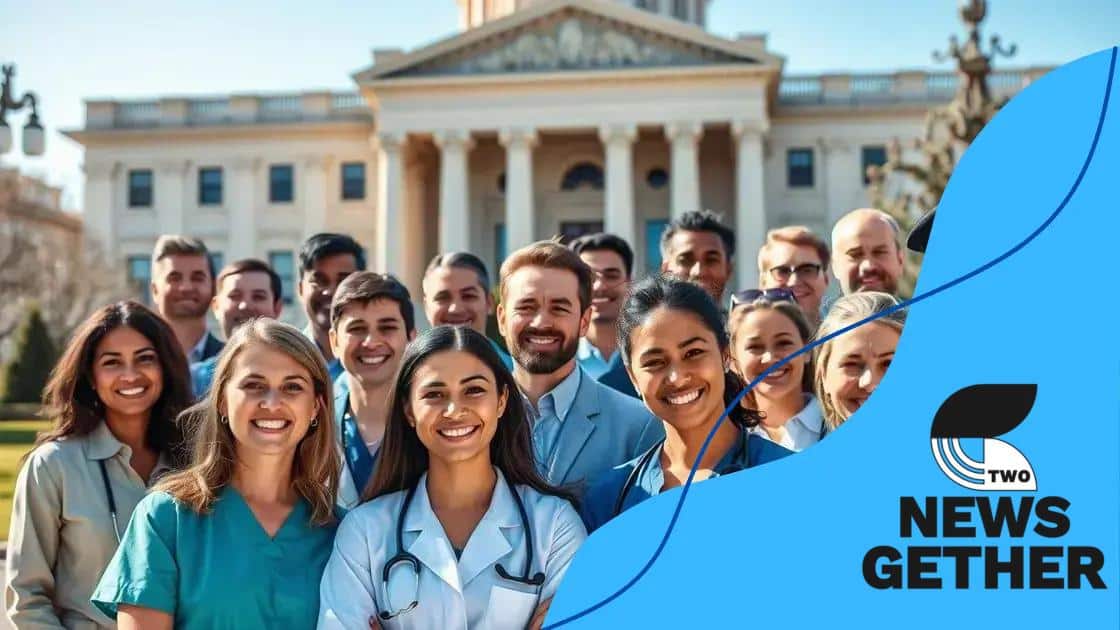Federal student loan forgiveness programs for public servants

Federal student loan forgiveness programs for public servants allow eligible employees to have their remaining loan balance forgiven after fulfilling specific requirements, including making a certain number of qualifying payments while employed full-time in public service.
Federal student loan forgiveness programs for public servants offer remarkable opportunities to ease financial burdens. Have you ever wondered how these programs work and who qualifies? Let’s explore this essential topic to help you navigate your options.
Understanding federal student loan forgiveness
Understanding federal student loan forgiveness is crucial for anyone working in public service. These programs can help reduce or eliminate your student debt, making your financial future brighter. Let’s break down what these forgiveness programs entail and how they can benefit you.
What is federal student loan forgiveness?
Federal student loan forgiveness refers to programs that cancel part or all of your federal student loan debt after you meet certain criteria. This is especially aimed at individuals in public service careers, such as teachers, nurses, and first responders.
Who qualifies for forgiveness?
To be eligible for federal student loan forgiveness, you typically need to be employed full-time in a qualifying public service position. Your loans must be federal, and you need to make a specific number of payments under a qualifying repayment plan.
- Check your loan type: Only federal loans qualify.
- Work in public service: Employment at non-profits, government, and certain other organizations counts.
- Stay on the right repayment plan: Track your payments carefully.
Many people are unaware of the eligibility requirements, which can vary between different programs. For instance, the Public Service Loan Forgiveness (PSLF) program has unique requirements that differ from other forgiveness options.
Signs of a robust program include a clear pathway to qualify and an understanding of the application process. To maintain eligibility, ensure you are recertifying your employment each year and keeping your lender informed of any changes in your job status.
Types of forgiveness programs
There are several types of student loan forgiveness programs available for public servants. Each has its own set of rules and benefits. Here’s a quick overview:
- Public Service Loan Forgiveness (PSLF)
- Teacher Loan Forgiveness
- Nurse Corps Loan Repayment Program
- National Health Service Corps (NHSC) Loan Repayment Program
Exploring these options can lead to significant savings and peace of mind regarding your student loan debt. Many public service workers have successfully navigated these programs to reduce their financial burdens.
Eligibility criteria for public servants
Understanding the eligibility criteria for public servants seeking loan forgiveness is vital for those pursuing financial relief. These criteria can vary based on the specific forgiveness program, yet they generally focus on your employment status and the type of loans you hold.
Basic eligibility requirements
To qualify for federal student loan forgiveness, you need to meet specific conditions. Typically, this includes working full-time for a qualifying employer, such as government agencies or non-profit organizations.
- Must be employed by a qualifying organization.
- Must work at least 30 hours per week.
- Should be making qualifying payments on your loans.
It is important to verify if your employer meets the criteria for the particular program you are considering. Additionally, not all student loans qualify for forgiveness, so checking the type of loans you have is crucial. Many public servants may have federal direct loans, which are eligible for most forgiveness programs.
Other factors to consider
Your repayment plan also plays a significant role in determining eligibility. For example, those on income-driven repayment plans may have different requirements compared to those on standard repayment plans. Keeping track of your payment history can greatly benefit your chances of achieving forgiveness.
It’s also critical to review the program’s requirements periodically. Sometimes, policies and eligibility guidelines change, affecting your capacity to qualify. Staying informed can help you navigate the complexities of student loan forgiveness more effectively.
Lastly, maintaining accurate records of your hours worked and payments made can streamline the application process. This way, you will have all necessary documentation ready when it’s time to apply for forgiveness.
Types of forgiveness programs available

There are several types of forgiveness programs available for public servants, each designed to assist different professionals with their student loan debt. Understanding these options is key to making informed decisions about your financial future.
Public Service Loan Forgiveness (PSLF)
The Public Service Loan Forgiveness program is one of the most well-known options. It is aimed at federal employees and those working for non-profit organizations. After making 120 qualifying monthly payments while working full-time for a qualified employer, the remaining balance on your loans may be forgiven.
Teacher Loan Forgiveness
Teachers who work in low-income schools or educational service agencies may qualify for Teacher Loan Forgiveness. Eligible teachers can receive forgiveness of up to $17,500 on their Direct Subsidized and Unsubsidized Loans after five consecutive years of teaching.
- Must teach full-time for five years.
- Work in a low-income school.
- Hold a valid teaching certificate.
Nurse Corps Loan Repayment Program targets nurses who work in critical shortage areas. This program offers repayment assistance in exchange for a commitment to service in underserved communities. Nurses may receive up to 85% of their loans repaid over a two- or three-year commitment.
National Health Service Corps (NHSC) Loan Repayment Program
The NHSC Loan Repayment Program offers benefits to healthcare providers who work in Health Professional Shortage Areas. Providers can earn up to $50,000 to help repay their student loans in exchange for a two-year commitment.
Eligibility for various programs often requires participants to stay current on their loans and maintain qualifying employment. Familiarizing yourself with the specific criteria for each program can greatly enhance your chances of qualifying.
In addition to these, there are other loan forgiveness options based on profession, such as those for lawyers who work in public interest law or for social workers. Always check the specific program requirements to ensure you understand the benefits available to you.
Application process for student loan forgiveness
The application process for student loan forgiveness can seem daunting, but breaking it down into clear steps makes it manageable. Understanding what to expect is key to ensuring you meet all requirements and deadlines.
Gather necessary documents
Before starting your application, gather important documents. This includes proof of employment, your loan information, and any records of payments made. Having everything in one place can streamline the process.
Fill out the application
The first step in applying involves completing the appropriate application form for the forgiveness program you are interested in. Most programs, such as the Public Service Loan Forgiveness (PSLF), require specific forms that need to be submitted for evaluation.
- Complete the Employment Certification Form for PSLF.
- Provide your personal information accurately.
- Include details about your employer and years of service.
Once your application is filled out, recheck for any mistakes or missing information. Incomplete applications can lead to delays.
Submit your application
After ensuring the application is complete, you can submit it to your loan servicer or the designated agency for the program. Some applications can be submitted online, while others may require mail.
Be sure to keep copies of everything you submit. This helps track your application and may be useful if questions arise later.
Follow up on your application
After submitting your application, stay in touch with your loan servicer. They can provide updates on the status of your application. You can also inquire about the timeline and if any further action is needed from your side.
Regular follow-ups can help ensure that your application is processed and reduce the chance of any issues. Many programs have set processing times, so asking for clarifications can help you know what to expect.
Maintaining clear communication with your loan servicer throughout this process can make a significant difference in how smoothly your application goes.
Tips to maximize your forgiveness benefits
Maximizing your forgiveness benefits is essential for anyone looking to alleviate their student loan debt. By following certain strategies, you can increase your chances of successfully receiving loan forgiveness.
Understand program requirements
Each forgiveness program has specific requirements. It’s crucial to familiarize yourself with these details. For example, the Public Service Loan Forgiveness (PSLF) program requires 120 qualifying payments while employed full-time at a qualifying employer.
Stay organized with your payments
Keep track of your payments meticulously. Use a calendar to log your payment due dates, and ensure that you are making payments on time. Missing a payment could delay your progress toward forgiveness. Document every payment you make to support your application later.
- Set automatic payments if possible.
- Request payment confirmations.
- Maintain a record of your payment history.
Consider consolidating your loans if you have multiple loans. This can simplify tracking and payments, but ensure that any consolidation does not erase your eligibility for forgiveness.
Recertify your employment regularly
Make it a point to recertify your employment annually. This step is vital for programs like PSLF. It confirms that you are still employed with a qualifying employer, helping to keep your application on track and ensuring your progress toward forgiveness.
Another important tip is to communicate regularly with your loan servicer. Keeping an open line of communication helps address any questions or concerns you may have about your status or the application process.
Explore additional forgiveness options
Don’t limit yourself to just one forgiveness program. Research all options available to you. Different professions might have unique forgiveness benefits. Check programs designed for your field, like teaching or healthcare, to find the best fit.
Finally, consider consulting with a financial advisor who understands student loans and forgiveness options. They can provide personalized advice and strategies tailored to your situation, helping you navigate the complexities of federal student loan forgiveness.
FAQ – Frequently Asked Questions about Federal Student Loan Forgiveness
What is the Public Service Loan Forgiveness program?
The Public Service Loan Forgiveness (PSLF) program forgives the remaining balance on your federal loans after you make 120 qualifying payments while working full-time for a qualifying employer.
Who qualifies for student loan forgiveness programs?
Generally, public servants working for government organizations or non-profits qualify, but specific eligibility varies among different programs.
How do I apply for a student loan forgiveness program?
To apply, you need to gather necessary documents, complete the required application form, and submit it to your loan servicer.
What can I do to maximize my loan forgiveness benefits?
Stay organized with your payments, understand your program’s requirements, recertify your employment regularly, and consult financial advisors for guidance.






